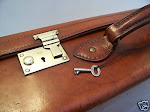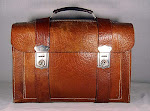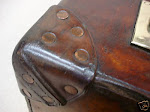Introduction:This web page is intended to give basic leather cleaning and restoration guidance to anyone who wants to carry out repairs and restoration to old leather articles.
Please note: this is not aimed at museum conservators who will already have complex processes in place for conserving precious leather artifacts. This is a basic common sense guide to 'leather fettling' for ordinary folk, written with the backing of more than thirty years experience in the leather trade and is written without any guarantees - either implied or explicit!
Oak bark tanning:
Until fairly recently, most tanning was carried out using a process that relied on the tannin from oak and other types of bark to preserve the leather. Now, it is believed that we only have one tannery left in the UK that makes oak tanned leather. This means that finding replacement leather which looks and feels right as apart of a restoration project can be very difficult. Chrome tanned leather is rarely an adequate substitute.A very small number of specialist craftspeople now carry stocks of appropriate leather so make sure you have sourced all your materials before you start to take a piece of work apart for repair.
Take a look at: http://www.barefootleather.co.uk as they are repairers and renovation specialists. They stock a range of period leather and linen threads plus rivets and buckles suitable for restoration projects.
Machine stitching:
Much of the leatherwork you will find has been machine stitched. It is often difficult to match this with hand stitched work so you may want to find a repair shop that still uses the old style machines - many machines were made by Singer and Bradbury and for heavy work many leather craftsmen used a range of machines built by British United Shoe Machinery (BUSM); these included the almost indestructible Pilot which can still be found in use today.
Know the extent of the problem before you start:
Begin by gently and carefully brushing the leather item (a large, fairly soft artist’s paintbrush is ideal) to remove any loose surface material. Starting with a small inconspicuous area, try dipping the brush in methylated spirit to help you to remove dust and dirty marks.Deal with a small area at a time and be careful not to soak the leather. Always use meths sparingly and beware of naked flames. Allow the leather to dry thoroughly after cleaning.
When the leather is clean, look for loose or damaged stitching and make a note of what needs to be repaired. Check any buckles, rivets and hardware and make a note of exactly what needs to be done with them. Always take photographs if you want to replace broken fittings. It is much easier to send a good digital image by email than explain what a buckle looks like over the phone.The object of this exercise is to understand the extent of the task before you start work. That way, you won’t take on more than you feel confident to handle.
Take a look at: http://www.barefootleather.co.uk as they are repairers and renovation specialists. They stock a range of period leather and linen threads plus rivets and buckles suitable for restoration projects.
Restoring colour and re-finishing old leather:
Most leather items will have faded and lost colour over the years. Re-dying with bright, vibrant colours is not particularly difficult; but it can be risky as you will almost certainly have no idea what products have been applied to the leather item since it was made.
Most early leatherwork was originally dyed with fairly sombre colours. Shoes and handbags made with pre-war leather were sometimes available in brighter but still 'muted' colours but black and shades of brown and tan were prevalent.
To match these colours you will need to source a range of spirit based dyes. Fiebings produce excellent dye and supply it in relatively small pots which are ideal for restoration jobs. It isn't particularly cheap so spend time matching your project against the colour charts to make sure you get the right colour dye.
The best way to buy your dye may be to take your project to a specialist repair shop and ask them to show you their range of dye colours on a strip of veg-tan leather finished with a wax top coat. This will give you a good idea of the final colour match.
Before you begin to dye the project make sure it is absolutely clean and any polish or surface wax has been removed. If this is not carried out then you risk 'spotting' as wax resists dye. It is possible to buy cleaning and de-greasing products but for most purposes methylated spirit will work well enough.
Using a cotton bud, start work on an inconspicuous part of the project and ensure the leather responds well to the cleaner. If there is any sign of bubbling or flaking stop work and seek expert advice.
When your leather is clean and you have tested for adverse reactions, using a wool daub (Fiebings supply one with every bottle of dye) start to colour the project. Use long, overlapping strokes of the daub and repeat the process if your work develops streaks. You are aiming for an even colour all over. Note: An artist's or modelmaker's airbrush can be extremely useful as it will allow dye to be applied evenly over an entire project.
Make sure any areas that are not to be coloured are adequately masked using appropriate paper and masking tape.Remember: sunlight fades leather very quickly and being kept in a centrally heated house will dry it out so it is important to 'feed' your leather soon after dying. Use a good quality product like Skidmore's Restoration Cream as this will help to make and keep the leather supple.
Hand stitching:
Almost all British leathergoods (including many handstitched items sold by saddlers and harness makers around the country) were made in factories in the West Midlands. It is well worth a trip to the Leather Museum in Walsall to find out more. Many items were machine stitched which can pose problems for a restorer.
It is very difficult to replicate a machine stitch by hand, but with care a respectable job can be done. First clean out all the old thread from the area that needs to be repaired. Use your brush and a pair of tweezers to ensure the job is properly clean before you start. A scalpel is useful to cut away loose threads.
It is possible to find linen threads in various colours and sizes similar to those used by the original machinists but it is essential to make as good a match as possible if the repair is to look respectable.
Having cleaned out the stitch holes, and using two blunt harness makers needles - threaded one on each end of a length of beeswaxed linen thread - carefully start to restitch the damaged area. Do not use sharp embroidery needles as these can damage the leather fibres and are harder to work with.First pass the thread through the stitch holes until you have an even amount each side. Then take one needle and pass it halfway back through the work and take the other needle and do the same.
Grasping both needles, one in each hand, pull them through the work and tighten the thread to make a stitch. Be careful not to pull the thread too hard as the leather will tear through very easily. Continue until you have made the repair. To finish the job, simply back stitch two or three holes and cut the loose ends off close to the work.
Crocodile and snake skin restoration:
Reptile skin is both resilient and hard wearing. The problems occur when it is allowed to dry out. Once again, before starting any kind of repair work, feed the leather with a little Skidmores Restoration Cream rubbed in with your fingertips until it becomes supple. It make take several applications before the leather has enough elasticity to handle being sewn.
Never try to force a sharp needle through reptile skin as it will often split. use a very sharp awl to prick holes through the skin and then follow the awl with a blunt needle and thread before the hole closes again.
Cleaning crocodile or snake skin:
Reptile skin that is very dusty or dirty needs to be cleaned before restoration cream is applied. Vaccum away dust and surface dirt and carefully clean the skin with a soft brush and little warm water and saddle soap followed by a good quality liquid leather conditioner like Lexol. Make sure all the saddle soap is rinsed off and the leather is completely clean before spraying lightly with Lexol. Allow the Lexol to soak in and dry then finish off with Skidmore's Restoration Cream to seal the surface again.
Note: Do not use detergents as these strip any remaining oils from the skin.
Skidmore's Restoration Cream is available online at http://www.barefootleather.co.uk
Cleaning kid gloves:
Light coloured kid gloves can be cleaned by rubbing with a piece of soft white India rubber. Clean the rubber on blotting paper as it becomes soiled.
A 1940s 'make do and mend' trick was to wash very soiled light coloured gloves in a basin of petrol. Soak the whole glove in the basin for a few minutes to loosen the dirt. . Take a small piece of white flannel and rub the fingers and dirty parts carefully. Then rub the gloves lightly with the hands with an ordinary washing movement, and wring them out carefully. The cleaned gloves should then be pulled gently into shape and hung out to dry in the fresh air. The smell should vanish in a few days.
To clean coloured leather gloves, mix together equal quantities of Fullers Earth (also known as calcium bentonite) and powdered or granulated alum, and rub the gloves all over with the mixture. Leave for two hours, then brush thoroughly to get rid of the powder.
Restoration problems:
The main problems you will face are crumbling leather and splitting holes. If this becomes an issue then work a little Skidmore's Restoration Cream into the leather and leave it overnight to soak in. The following day you may find the leather has enough elasticity for you to proceed with your repair. If not then you may need to contemplate asking a leatherworker to fit a neat patch over the damaged area.
Take a look at: http://www.barefootleather.co.uk as they are repairers and renovation specialists. They stock a range of period leather and linen threads plus rivets and buckles suitable for restoration projects.




